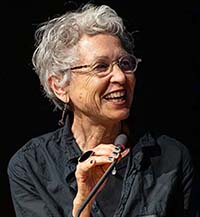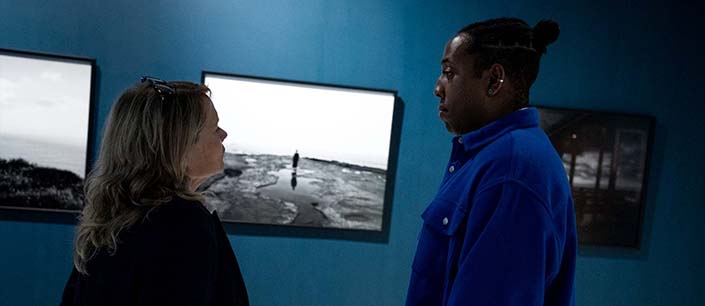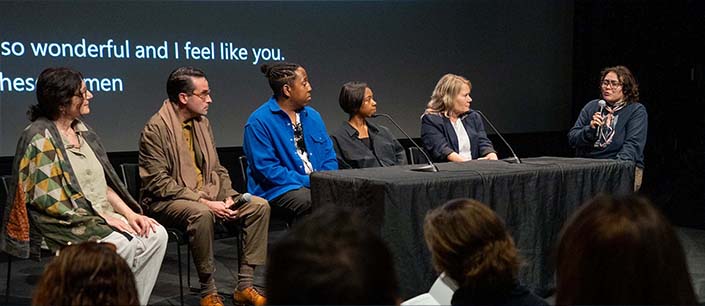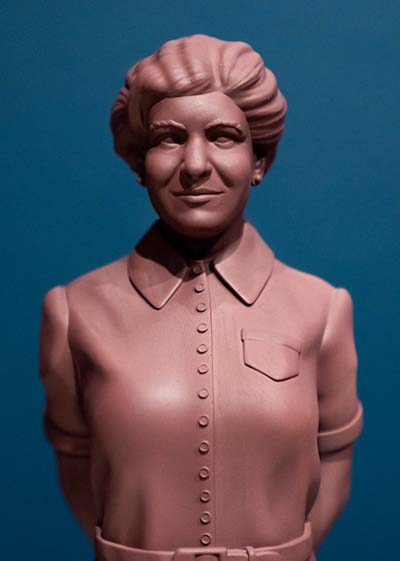Uncovering the Stories of Scripps Women Oceanographers
Story by:
Published Date
Article Content
A recent event opened “Three Lives,” an exhibit at Gallery QI that is part of the larger EMBODIED PACIFIC exhibition across UC San Diego and beyond. “Three Lives” focuses on Easter Ellen Cupp, June Grace Pattullo and Anita Smith Hall, who contributed to oceanography before women were accepted in the field. In the Gallery QI exhibit in Atkinson Hall, works by artists Amy Adler, Nicolas G. Miller, Johnnie Chatman and Jeffrey Stuker shed light on these women’s stories. An extension of the show, including pieces by Adler, Stuker, Kimberly Heard, Judit Hersko, Lauryn Smith and Chanell Stone, is on display in the UC San Diego Geisel Library. Curators include Lisa Cartwright, Joe Riley, Leandro Martínez Depietri, Clarissa Chevalier and Stephania Torres-Londono. Following are excerpts (edited for clarity and flow) from opening night.

“The ‘Three Lives’ project was, for me, a very important one. We are introducing three women oceanographers, two of them queer and one of them Black, who were first in the field: Easter Ellen Cupp, the first woman Ph.D. in oceanography [at UC San Diego's Scripps Institution of Oceanography, who became a high school science teacher after being passed over for a job in the field]; Anita B. Smith Hall, founder of the first marine biology program at a historically black college [Hampton University]; and June Pattullo [the first woman to receive a Ph.D. in physical oceanography who later worked under geophysicist Walter Munk]. It was interesting to find there was nothing about any of these women in the history outside of a few items in the archives, and that Anita Smith Hall was denied the opportunity to defend her dissertation despite having written it.”
— Lisa Cartwright, Curator and UC San Diego Professor of Visual Arts
“It was really interesting piecing together the available photography and trying to get a clear sense of who these women were. It was only really when I started drawing them that I was completely startled by their personalities that emerged in the drawings. It happened with every single one of them, which doesn’t always happen when I’m drawing people. I just started drawing them, and they literally appeared and wanted to be articulated and rendered and present. When I see these images now all over the place, it’s exciting because I think that they are women [who] were invisible and now they’re highly visible, and it’s through the medium of drawing.”
— Amy Adler, Artist
“[My piece] brings the element that is essential to all these women, which is water. I made an abstract seascape of the San Diego ocean to bring it into the space to speak to what’s lost beneath the surface. The picture is an ashen gray-black, and because it’s an abstraction, it takes time to understand what you’re looking at, but it’s essentially the shore breaking across the ocean, inverted vertically. I was thinking about that, the water, and just literally how archives are lost and the idea of just how astonishing that is.”
— Chanell Stone, Artist
“With my photographs, I was interested in the relationship each of the researchers had with the coastline, throughout their studies and personal engagements — whether it was looking at the aerial views of waves or exploring around La Jolla Shores, such as in the photographs taken by Easter Ellen Cupp. So, I, over a course of weeks, explored up and down the San Diego coastline. Using my mother as a surrogate figure, I sought to make visual a presence that had been absent from the landscape in order to think about their legacies and what it means to honor these spaces and their complex histories.”
— Johnnie Chatman, Artist and Ph.D. Candidate in Art History
“The archives are just so wonderful, and I feel like you definitely get a sense of who these women were just through their materials. … For context, women were not officially allowed to go onto Scripps Institution of Oceanography research vessels alone until like the late ’60s, and thus they were likely not present in the liquid environments they studied. So even though their works are very physical and embodied, there is still a dissection from the ocean. And that sense of absence is held within the exhibition itself.
— Stephania Torres-Londono, Curator and UC San Diego Visual Arts Graduate Student

“The drawing practice of Easter Ellen Cupp is what really came to the fore and what was undeniable to me in the archive: here we have a trove of hand-drawn scientific descriptions of marine diatoms, and before that freshwater diatoms. There are graphic languages that Cupp had to come up with in order to make what she firmly believed were scientifically accurate descriptions. The morphologies of these species, the line work, the continuous tonal shading and the different productions of value in her work were really exciting to me. So, in some sense, whatever level of exclusion Cupp faced somewhat ironically produced this very much embodied, very much physical trace of her body directly working with camera lucida attachment to the light microscope at Scripps. She was drawing the diatoms from life, and, with rare exception, was taking photographic plates of them and then sometimes even heavily modifying those with collage techniques.”
— Jeffrey Stuker, Artist


“My research has focused on the absence of women from the history of science, and the story of Easter Ellen Cupp is a case in point. It was very painful for Dr. Cupp when she lost her position at Scripps and could not pursue oceanography. Scientists continued to reach out to her asking for information about diatoms, which was her area of expertise. Many addressed her as Mr. Cupp assuming she was a man, and it was clear from this correspondence that her contributions to the field were greatly respected. There are numerous letters in the archives where she is answering scientists from all over the world, telling them that she no longer has access to a microscope or a lab and is unable to further her knowledge. Despite her enormous accomplishment, being the first woman in North America to receive a Ph.D. in oceanography, she was unable to fulfil her promise.”
— Judit Hersko, Artist and Professor at California State University San Marcos
“I chose to bring each of the women featured in Three Lives into sculptural form as statuettes. The statuette in sculpture has recently returned to some prevalence with the advent of 3D modeling and printing. In preparation for sculpting each figure I collected portraits of Anita Smith Hall, Easter Ellen Cupp and June Grace Patullo from the different moments in their lives. The images were used as references to digitally sculpt each figure in the round. I think of the statuettes as frozen montages of each woman’s life. What I enjoyed most about making these statuettes was the opportunity to reflect on what is molded into the historical record and what is not — and the role art can play in a process of collective remembrance.”
— Nicolas G. Miller, Artist [commenting after the event]
To watch the “Three Lives” discussion, see the video below, or go to the Qualcomm Institute YouTube channel.
“Three Lives” is part of the larger EMBODIED PACIFIC exhibition, a PST ART: Art and Science Collide partnership between UC San Diego Visual Arts and Birch Aquarium at Scripps Institution of Oceanography. EMBODIED PACIFIC features projects at six venues by 30 artists working with researchers in laboratories, field sites, and archives in SoCal and the Pacific Islands.
Share This:
You May Also Like
Stay in the Know
Keep up with all the latest from UC San Diego. Subscribe to the newsletter today.




